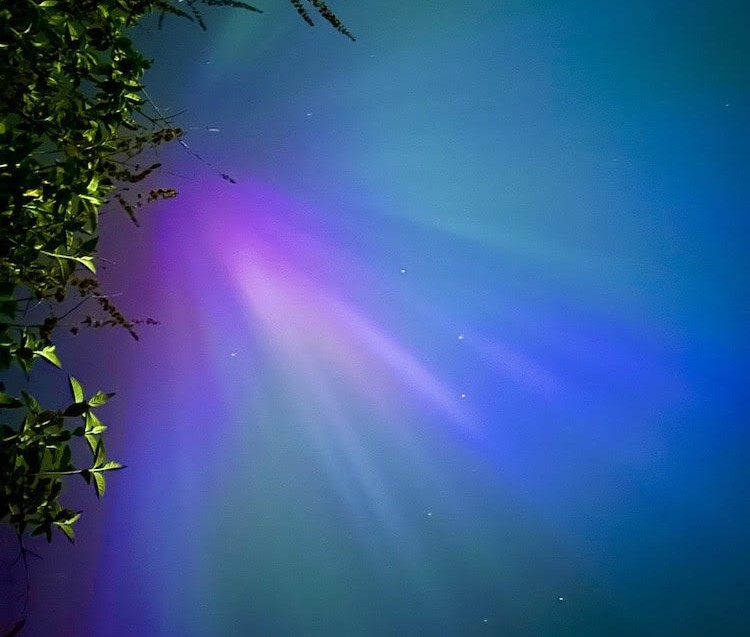Aurora Illuminates Ladakh’s Hanle Amidst Solar Storm

Aurora Illuminates Ladakh's Hanle Amidst Solar Storm
The Dark Sky Reserve in Ladakh’s Hanle witnessed an uncommon occurrence as an auroral red arc emerged, adding a touch of mystique to the already enchanting landscape.
11th May 2024
In a mesmerising celestial spectacle, Ladakh’s usually remote Hanle region became the stage for a breathtaking display of the aurora borealis, commonly known as the Northern Lights. This phenomenon, triggered by an intense solar storm, painted the night skies with vibrant hues, captivating onlookers and astronomers alike.
Unlike traditional auroras, which exhibit dynamic patterns and a range of colours, these arcs possess a fixed hue and remain static, marking them as a unique spectacle during potent geomagnetic storms.
For an unparalleled glimpse into the cosmos, consider adding Hanle in Ladakh to your travel itinerary. This region, comprising six hamlets including Bhok, Shado, Punguk, Khuldo, Naga and Tibetan Refugee habitations within the Changthang Wildlife Sanctuary, has recently been designated as the Hanle Dark Sky Reserve.
Covering an area of 1,073 square kilometres around the Indian Astronomical Observatory, this reserve ensures the preservation of darkness, facilitating optimal conditions for scientists and astronomy enthusiasts to observe the pristine night sky.
Long before its designation as a Dark Sky Reserve, Hanle was selected by the Indian Institute of Astrophysics as the site for an observatory. According to Dorje Angchuk, the engineer overseeing the Indian Astronomical Observatory at Hanle, the region’s dry and cold climate played a crucial role in this decision. Angchuk explains that Hanle’s minimal moisture content ensures that atmospheric absorption of light is limited, allowing for optimal visibility of distant celestial sources. Having spent 25 years in Hanle, Angchuk attests to the favourable conditions for astronomical observations provided by the region’s dry atmosphere.
The awe-inspiring display wasn’t limited to Ladakh alone; it graced various corners of the globe, including Russia, Australia and Germany. In Russia, the aurora borealis cast its characteristic shimmering curtains across the night sky, while in Germany, the northern regions were bathed in an ethereal glow. Down under, Australia experienced the aurora australis, or the Southern Lights, showcasing vivid red and purple hues that mesmerised onlookers, especially in Tasmania.
The intense solar storm responsible for this celestial showcase stemmed from a coronal mass ejection (CME) from the sun. These CMEs, the largest eruptions on the sun’s surface, propel massive amounts of energy and charged particles into space. As these particles interact with the Earth’s magnetic field and atmosphere, they produce the captivating light displays witnessed during auroras.
Scientists are closely monitoring the developments, particularly focusing on sunspot AR3664, which has been expanding and rivalling the Carrington sunspot last observed in the 1800s. This sunspot serves as the epicentre for all five coronal mass ejections currently en-route to Earth. Captured by the Solar and Helio spheric Observatory, a coronagraph movie depicts these mega eruptions emanating from the sun, offering valuable insights into these solar phenomena.
The anticipation mounts as five significant coronal mass ejections are poised to traverse the solar system and potentially affect Earth over the coming weekend. While auroras provide captivating visual spectacles, they also serve as reminders of the intricate dance between the sun, Earth’s magnetic field and the delicate balance of our planet’s atmosphere. As scientists continue to study and understand these phenomena, their insights contribute to our broader understanding of space weather and its impact on our planet.
While Ladakh’s Hanle region provided a picturesque backdrop for the recent auroral display, the global reach of this phenomenon highlights the interconnectedness of Earth and the cosmos. As we marvel at the beauty of auroras, we also gain deeper insights into the dynamics of our solar system and the celestial forces at play.








